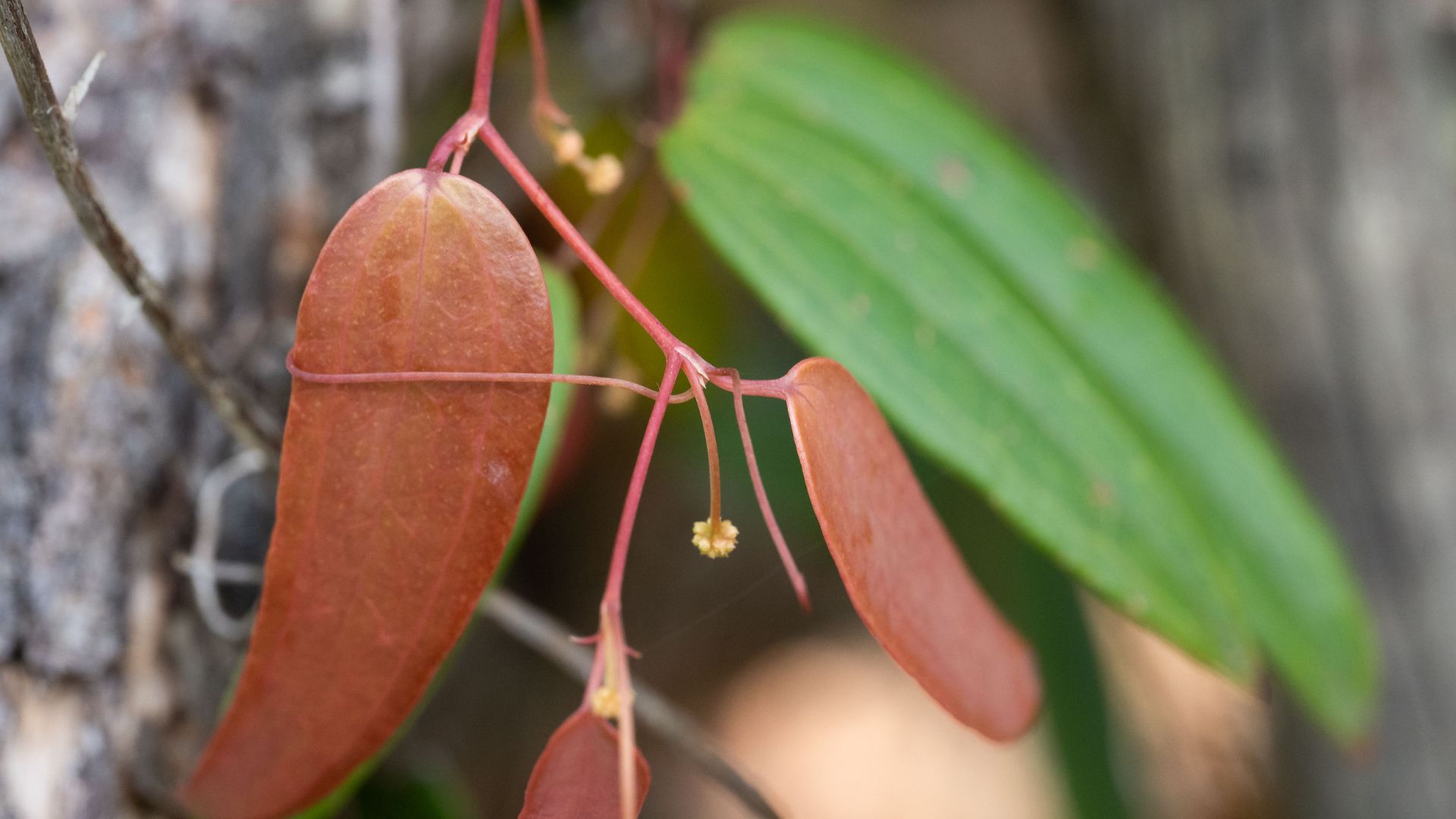
24 Oct Spring In Sydney: Eating Bush Tucker on Sydney’s Trails: Native Sarsaparilla
Whether training for treks or just out for a walk, my favorite on hike bush tucker snack at this time of year is the Native Sarsaparilla. Its tender new shoots boast an awesome taste. It has a unique flavor, almost reminiscent of medicine, with a fascinating history tied to its use as a restorative among indigenous communities.
The Native Sarsaparilla Plant
Native sarsaparilla (Smilax glyciphylla), also known as sweet sarsaparilla or wild sarsaparilla, is a climbing plant native to Australia. It belongs to the Smilacaceae family and can be found in various regions, including rainforests, woodlands, and coastal areas. The plant has a fascinating growth pattern, with tender new shoots emerging during specific times of the year, often signaling the arrival of spring or summer.
The Alluring Taste of Native Sarsaparilla
One of the most intriguing aspects of native sarsaparilla is its taste. The flavor profile of the young shoots is quite distinctive, with a unique blend of sweetness and herbal notes that resemble the taste of traditional medicines. The vibrant red shoots are particularly sought after, as they boast a strong and juicy flavor. While some (like me) may enjoy chewing the shoots straight from the bush, others might prefer to brew sarsaparilla tea.
Traditional Usage and Historical Significance
Native sarsaparilla has a rich history deeply intertwined with the traditions of indigenous Australian communities. Among these groups, the plant was revered for its perceived restorative properties, and it was often used to help those who were unwell. When early settlers arrived in Australia, the locals taught them the use of sarsaparilla as a remedy for various ailments.
The Science Behind Native Sarsaparilla
Beyond its cultural significance, there is scientific merit to the traditional use of native sarsaparilla. The plant contains various bioactive compounds, some of which have shown potential health benefits. While more research is needed, initial studies have revealed interesting findings.
Antioxidant Properties: Native sarsaparilla is rich in antioxidants, which play a crucial role in neutralizing harmful free radicals in the body. Antioxidants help protect our cells from oxidative stress, thereby potentially reducing the risk of certain chronic diseases.
Anti-Inflammatory Effects: Some studies suggest that certain compounds found in sarsaparilla may exhibit anti-inflammatory properties. Inflammation is a natural immune response, but chronic inflammation is linked to several health issues. Consuming plants like native sarsaparilla with anti-inflammatory potential could be beneficial.
Potential Antimicrobial Activity: Traditional medicine often utilized sarsaparilla for its antimicrobial properties. While research is ongoing, some studies have demonstrated its ability to inhibit the growth of certain bacteria and fungi.
Cautionary Note
Although native sarsaparilla has a remarkable history and potential health benefits, it is essential to exercise caution when consuming it. While many people can enjoy its delicious flavor and unique attributes, there are some considerations to keep in mind:
Identification: Properly identifying native sarsaparilla is crucial to avoid confusion with similar-looking plants, some of which could be toxic. It is advisable to seek guidance from local experts or experienced foragers before consuming any wild plant.
Allergies and Sensitivities: As with any new food, some individuals may be allergic or sensitive to certain compounds in native sarsaparilla. It is wise to test a small amount before indulging in larger quantities.
Preparation: If you choose to make sarsaparilla tea or any other preparation, ensure you handle and process the plant correctly to avoid any potential risks.
Often confused on google with the purple flowered False Sarsaparilla. This is also a traditional medicine and bush tucker that can be used as a tea to relieve toothaches, sore throats, and maintain a healthy gut.
You can find out more about identifying Native/Sweet Sarsaparilla and False Sarsaparilla here:
https://www.selfsufficientculture.com/ams/aussie-bush-tucker-an-introduction-to-common-native-foods-of-australia.16/page/native-sarsparilla-part-13.14/
Enjoy,
Joe
PS: Planning an adventure?
Start Here with 5 simple ways I can help you now!
STEP #1 FREE TRAINING
Get our free training
STEP #2 BOOK
Get the Complete Guide to Altitude Illnesses handbook
STEP #3 LECTURES
Get the Altitude workshops course
STEP #4 DASHBOARD
Get the ADVENTURE PLANNING DASHBOARD
STEP #5 TRAINING & PREPARATION
Need help focusing on what you need to do?
References
Cox SD, Jayasinghe KC, Markham JL. Antioxidant activity in Australian native sarsaparilla (Smilax glyciphylla). J Ethnopharmacol. 2005 Oct 3;101(1-3):162-8. doi: 10.1016/j.jep.2005.04.005. PMID: 15885944.
Salas-Coronado R, Hernández-Carlos B, Llaguno-Guilberto J, et al. (2017) Phenolic Compounds in Genus Smilax (Sarsaparilla). Phenolic Compounds – Natural Sources, Importance and Applications. InTech. DOI: 10.5772/66896.



No Comments